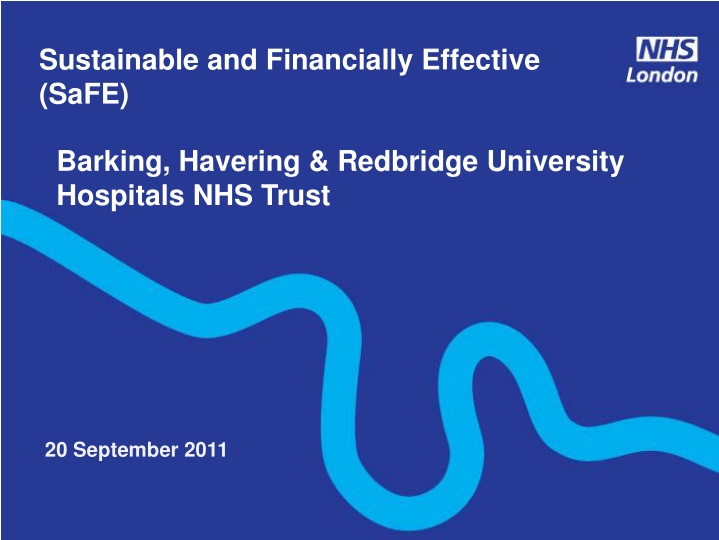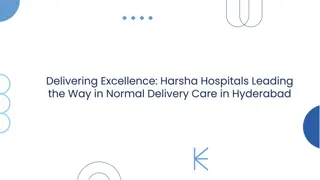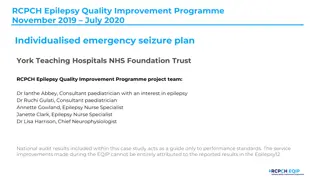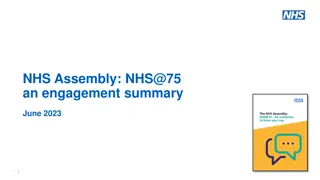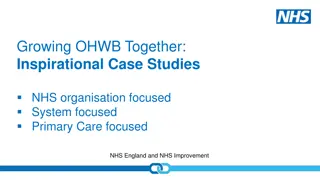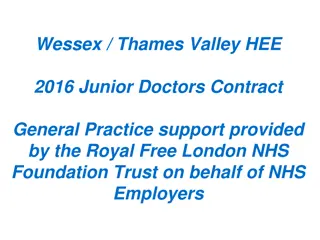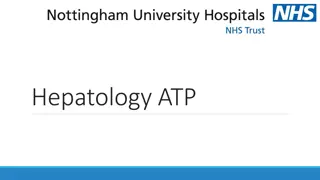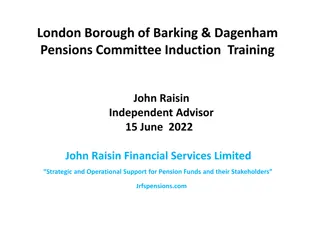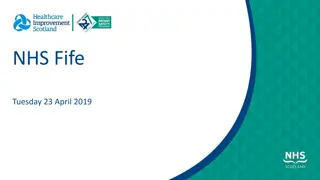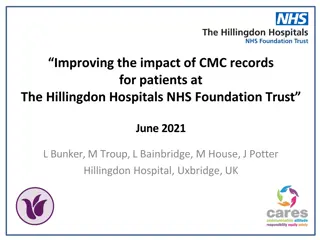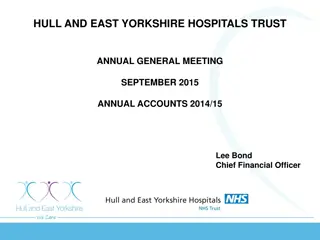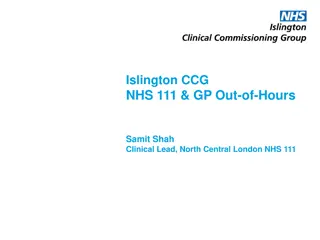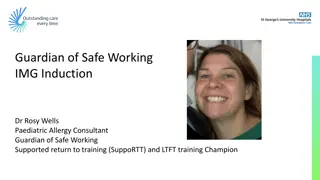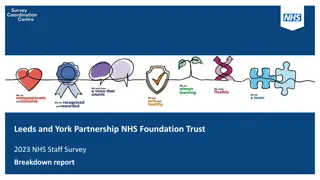SaFE Barking, Havering & Redbridge University Hospitals NHS Trust Report
The report discusses the challenges faced by the NHS in London due to increasing demand, funding shortfalls, and the need for service reconfiguration. It highlights the necessity for achieving clinical sustainability and financial viability to ensure Trusts can attain Foundation Trust (FT) status. The document outlines a simulation model, SaFE, to evaluate the readiness of 18 acute NHS Trusts in London to achieve FT status by 2014, considering financial projections, quality standards, and productivity enhancements.
Download Presentation

Please find below an Image/Link to download the presentation.
The content on the website is provided AS IS for your information and personal use only. It may not be sold, licensed, or shared on other websites without obtaining consent from the author.If you encounter any issues during the download, it is possible that the publisher has removed the file from their server.
You are allowed to download the files provided on this website for personal or commercial use, subject to the condition that they are used lawfully. All files are the property of their respective owners.
The content on the website is provided AS IS for your information and personal use only. It may not be sold, licensed, or shared on other websites without obtaining consent from the author.
E N D
Presentation Transcript
Sustainable and Financially Effective (SaFE) Barking, Havering & Redbridge University Hospitals NHS Trust Text 20 September 2011 1 Footnote SOURCE: Source 0
Agenda 1 Introduction 2 Methodology 3 Conclusions for BHRT (from Phase 1) 4 Supporting London Acute Productivity Gain 5 Discussion Points Appendix Peer Groups Medical Oncosts for BHRT 1
Introduction Healthcare for London, published in July 2007, illustrated a compelling case for change in health and healthcare services across London. Four years on, the case for change is as powerful as ever. London s NHS faces pressure from increasing demand for healthcare: a growing and ageing population; changing patterns of disease and health; innovations in medical technology; and changing public expectations. which alongside the slowdown in funding growth for the NHS poses a significant challenge to the overall affordability of London s healthcare system. In 2009, NHS London undertook detailed modelling that showed that on a do nothing basis, by 2016/17, there would be a 4.4billion funding shortfall for commissioners in London on a recurrent basis over a 9-year period, to be addressed by tariff pricing ( 2.4bn) and commissioning levers ( 2.0bn). Analysis also demonstrated additional pressure of up to 1.9bn on acute providers from activity changes. Implementing Healthcare for London proposed an approach, underpinned by financial analysis, that achieved both clinical sustainability and financial viability for PCTs in London. But major service reconfiguration and/or organisational changes would be necessary to deliver viable Trusts capable of achieving FT status. The NHS in London is running out of time to undertake these changes in order to achieve a viable provider landscape. Although London s integrated plan for 2011/12 and beyond reflected an updated commissioner model, in many cases PCT Clusters plans fail to reveal the scale of changes needed, partly because of the complex policy and political environment within which the NHS operates. Therefore, SaFE provides a simulation based on standardised modelling of financial, quality and safety issues. It is consistent across London and determines whether the 18 acute NHS Trusts in London can achieve FT status by 2014, taking into account current cost and income trajectories, quality requirements and potential productivity improvements. Following discussions with NHS leadership and Secretary of State, a number of workstreams have been developed to take this work forward, central to which is a dialogue with each Trust Board regarding its response to the challenges and opportunities presented by the analysis. This will inform the development of detailed milestones to be included in finalised TFAs. 2
Agenda 1 Introduction 2 Methodology 3 Conclusions for BHRT(from Phase 1) 4 Supporting London Acute Productivity Gain 5 Discussion Points Appendix Peer Groups Medical Oncosts for BHRT 3
Approach: We estimated Trusts financial position to 2014/15 in 5 steps Establish 10/11 baseline Used Trusts underlying position in 10/11 (net of non-recurrent income and costs) as baseline Forecasted income until 2014/15 based on 3 factors: Net clinical activity growth based on commissioner plans underlying demand growth assumptions (range 1.9%-5.0%) demand management net of reinvestment (range 1.1%-8.9%) Price reduction of -1.5% per year across both PbR and non-PbR clinical income Forecast of non-clinical income (R&D, education and training) based on NHS London teams view Modelling excludes all potential future reconfigurations and service changes Estimate income changes by 14/15 Estimated change in cost as a result of changes in activity (assuming cost scales 70-80% with increase in activity and 55-65% with decrease in activity)1 Added expected PFI cost development based on DH schedules Added non-activity-related operating expenses, assuming increases with inflation Estimated opportunity to reduce cost by closing productivity gap vs. benchmark peers: Peers selected considering Trusts academic/non-academic status, size and single/multi-site status where relevant Peers with bottom quartile quality excluded (HSMR used as proxy for quality) 2 levels of potential savings modelled: 1) Close gap vs. peer at upper quartile productivity threshold, assuming the peer reduces costs by 2% p.a. 2) Close gap vs average of top 3 peers , assuming the peers reduce cost by 2% p.a. To avoid assuming unsustainable nursing cost reductions, we set a floor of 8 nurse hours per patient bed day Set a cap of 20% reduction on the total cost base over 4 years as the maximum sustainable improvement Ensured Trusts met minimum medical resource standards for key specialties (Obstetrics and Emergency services) Inflated the cost base net of all other changes by 2.5% p.a. Estimate cost changes by 14/15 Used Trusts 2011/12 plans as short term forecast and re-profiled demand management and productivity improvement of the 4-year period accordingly Modelled impact of community services component of merged acute and community Trusts (assuming 3% surplus) Develop year-by- year forecasts Assessed Trusts viability based on whether they achieve 1% underlying net surplus position in 2014/15 For Trusts that would achieve 1% net surplus by 2014/15 if it were not for the 20% cap, the forecast period has been extended to check if the target can be achieved given more time Evaluate financial outlook 4 1 Cost scaling assumptions modelled at level of detailed cost categories, reflecting differences in proportions of fixed and variable costs
There are a number of potential downsides that have not been included in this analysis and that would make Trusts prospects of financial viability lower Assumption / approach in this work Potential downside Costs scaled at 70-80% with increases in activity, and 55-65% with decreases Some Trust operating plans imply higher scaling with increases and lower / no scaling with decreases Scaling 2.5%pa cost inflation assumed on all cost categories (based on the average cost inflation assumed in operating plans 2011/12) An alternative scenario with additional 1%pt unfunded cost inflation has been modelled Potential higher cost inflation through pay drift and other cost pressures Cost inflation -1.5%pa price reduction per year, across both PbR and non-PbR clinical income Additional price pressures from new tariff rules (e.g. emergency readmissions) Potential income caps imposed by commissioners if demand not contained Tariff uplift & price changes Only includes trust s agreed PFI and capex programmes (plus known requirements for immediate sustainability) Trusts with ageing estates may need major capex programmes beyond current plans PFI & other capex 5 SOURCE: SaFE modelling assumptions
We have limited the potential savings that can be achieved to 20% over the 4-year period, which is at the very top end of savings seen internationally We have set an upper limit on the total cost savings that can be achieved over 4 years based on not having seen evidence of higher levels of cost savings sustained over a long period Examples of hospital cost reduction programmes % reduction in total cost base, CAGR Time- frame The 20% cap translates to: 20% of total cost base over 4 years US private hospital 2-3 years ~5 5.4% annual cost reduction on total cost base Germany private hospital 24% of variable and semi-variable costs over 4 years 4-5 years 4-5 Portugal private hospital 6.6% annual cost reduction on variable and semi-variable costs 2-3 years 4-5 Germany public hospital ~4 3-4 years Sweden public hospital ~2 years ~4 The highest levels of productivity savings have only been achieved in the private sector 6
Costs to ensure minimum standards of emergency and maternity care included Early involvement of senior doctors in assessment and management of acutely ill patients improves health outcomes Emergency care Significant variation between clinical staffing levels on weekdays compared to weekends. In London s hospitals consultant cover at weekends is only half of what it is during the week, which means that patients admitted to hospital at weekends face a significantly increased risk of death. In London, the risk is in excess of 10%, meaning that there will be more than 500 deaths per year that need not have occurred Clinicians have developed a series of minimum standards for on-call 24/7 rotas, together with appropriate 24/7 consultant cover for A&E departments and for anaesthetics Estimated cost of implementing these across the 18 Trusts: 64m (2014/15) Royal College guidance emphasises the importance of midwives, 1:1 care during labour and increased presence of consultant obstetricians on labour wards. Maternity care London's maternity services do not perform uniformly well, with unacceptable inequalities in outcomes Due to concerns about the rate of maternal deaths in the capital - 19.3 deaths per 100,000 maternity episodes in 18 months - a review commissioned by NHS London into 34 deaths showed 26 had avoidable factors, some of which may have contributed to the outcome Estimated cost impact of recommended minimum standards for appropriate staffing levels of consultant obstetricians across the 18 Trusts: 6m (2014/15) 7
Agenda 1 Introduction 2 Methodology 3 Conclusions for BHRT (from Phase 1) 4 Supporting London Acute Productivity Gain 5 Discussion Points Appendix Peer Groups Medical Oncosts for BHRT 8
BHRT 2010/11-11/12 (Trust Operating Plans) Forecast underlying I&E 2010/11 to 2014/15 Units: m Income Costs 2010/11 14/15 2010/11 14/15 5 2 2 28 42 13 49 11 22 7 8 36 18 0 0 Net change of + 13m from - 6m 11/12 and + 19m 12/13 to 14/15 Net surplus 2014/15: - 36m (-9.2%)2 Net impact from volume changes = + 16m 440 435 400 398 Income 2010/11 Under- lying demand Demand manage- ment Tariff uplift Other oper- ating income1 Non oper- ating income Income 2014/15 Cost 2010/11 Impact of net change in activity Cost inflation PFI Other oper- ating ex- penses Non- oper- ating ex- penses Pro- duc- tivity Impact of new quality standards Cost 2014/15 Note: All figures are nominal (i.e. the effects of inflation are included in the future years). Cost inflation is applied after the effects of net changes in activity and productivity. 1 Includes R&D, education, private patient, etc. 2 Underlying net surplus modelled under DH Control Totals adjusted for non-recurrent items. 9 SOURCE: Trust Operating Plans 2011/12; Modelled impact of commissioning plans; Benchmark productivity targets
BHRT Forecast financial position 2010/11 to 2014/15 Units: m, % Matching peer at top quartile threshold (+2% with cap) Matching average of top 3 peers (+2% with cap) Underlying net surplus (in year), 2010/11 14/15 0 -5.0 -10.0 -15.0 Lines may overlap. EBITDA and net surplus shown for matching peer at top quartile threshold (+2% with cap) -20.0 -23.9 -26.7 -25.0 -30.8 -33.9 -30.0 -34.0 -36.4 -35.0 -38.7 -40.2 -40.0 -45.0 2010/11 (underlying) 2011/12 operating plan (underlying) 2012/13 forecast 2013/14 forecast 2014/15 forecast Underlying EBITDA % of income -0.9% -0.2% 1.4% 1.6% 1.2% Underlying net surplus % of income -10.0% -10.0% -8.7% -8.6% -9.2% SOURCE: 2011 Trust Operating Plan (Apr 2011); 2010/11 Trust draft accounts (Apr 2011); PCT Commissioning Plans (Apr 2011); Update to Monitor s financial assumptions (April 2011). 10
BHRT Benchmark analysis on cost saving opportunities Units: m, % Modelled scenarios on next page Cost savings (2010/11 14/15) Forecast underlying net surplus (2014/15) % CAGR m % m Required savings to achieve 1% surplus by 2014/15 7.2 115.7 4.0 1.0 Matching peer at top quartile threshold (+2% no cap) 4.7 77.3 -36.4 -9.2 Matching peer at top quartile threshold (+2% with cap) 4.7 77.3 -36.4 -9.2 Matching average of top 3 peers (+2% no cap) 6.3 101.5 -10.9 -2.7 Matching average of top 3 peers (+2% with cap) 5.4 89.1 -23.9 -6.0 NOTE: Benchmarks are based on current (2009/10) performance, so targets are increased 2%pt per annum to simulate the peer group continuing to improve over the period 2011/12 to 2014/15 (note that although benchmarks are based on 2009/10 performance, the 2%pt is not added for 2010/11 year because the baseline costs on which the savings are applied are 2010/11, so already includes the change for this year) 11 SOURCE: FIMS 09/10, Annual Reports 09/10 , HES 09/10, ERIC 09/10, Trust operating plan 2011/12 (for 10/11 underlying position)
BHRT Benchmark cost saving opportunities Units: m, % Cost saving opportunity (before adding 2% per year or 20% cap) Matching peer at top quartile threshold (Colchester) Matching average of top 3 peers (Sherwood, County Durham, Royal Cornwall) Current operating cost 10/11 Top quartile on each metric Category -5 -10 -11 ALOS1 87 -1 (-2%) -25 (-28%) -21 (-24%) Medical pay 110 -17 (-16%) -23 (-21%) -28 (-26%) Nurses pay2 44 -13 (-30%) -11 (-26%) -18 (-41%) ST&T pay 41 -14 (-35%) 0 (0%)4 0 (0%)4 Non-clinical pay 56 8 (14%) 2 (3%) 0 (0%) Clinical supplies 10 -1 (-5%) 0 (-4%) -1 (-13%) Other variable costs3 93 n/a n/a n/a Fixed costs5 440 -43 -67 -79 Total6 Savings (% of total costs) -10% -15% -18% -2.5% -4.1% -4.8% Savings (4-year CAGR) 1 Bed day opportunity estimated at 150/day. Note that ALOS is assumed to stay at current rate or move to target, whichever is shorter. Impact on costs is apportioned to other cost categories in the model (Medical 10%, Nursing 52%, ST&T 13%, Non-clinical 9%, Clinical supplies 16%) 2 Nursing WTE level capped at minimum of 8 nurse hours per occupied bed day 3 Other variable costs include catering, cleaning and laundry 4 Increase in costs capped to zero 5 Fixed costs include estate and establishment costs, and non-operating costs (PDC, interest, depreciation, etc.) 6 Total Trust expense used to arrive at net surplus 12 SOURCE: FIMS 09/10, Annual Reports 09/10 , HES 09/10, ERIC 09/10, Trust operating plan 2011/12 (for 10/11 underlying position)
BHRT Benchmark cost savings breakdown Peer at top quartile threshold Average of top 3 peers Top quartile on each metric Category Metric ratio Units Trust Casemix adjusted average length of stay2 ALOS1 5.5 5.0 4.6 4.5 Days Medical WTE per 1m clinical income Medical pay per medical WTE 2.8 89.5 2.1 2.2 81.9 2.1 90.5 WTE k Medical pay 114.3 Nurse WTE per 1,000 bed days Nursing pay per nurse WTE 6.9 32.1 5.0 38.2 5.4 32.8 5.2 31.8 WTE k Nurses pay ST&T WTE per 1,000 spells ST&T pay per ST&T WTE 7.2 38.9 7.3 25.7 5.3 39.2 4.9 33.5 WTE k ST&T pay Non-clinical WTE per 1,000 bed days Non-clinical pay per non-clinical WTE 2.9 28.8 2.8 18.6 3.8 43.5 3.5 26.7 WTE k Non-clinical pay Clinical supply costs per 1,000 clinical income 165.7 189.5 171.1 166.3 Clinical supplies Laundry cost per bed day Cleaning costs per bed day Catering costs per patient per bed day 3.2 14.1 7.9 3.9 14.6 5.4 3.6 13.3 7.5 3.3 13.4 5.4 Other variable costs Note: All figures are from 2009/10 1 Bed day opportunity estimated at 150/day. Reapportioned to other cost categories in the model (Medical 10%, Nursing 52%, ST&T 13%, Non-clinical 9%, Clinical supplies 16%) 2 Adjusted for differences in HRG mix, specialties and elective / non-elective inpatients. Daycases excluded from analysis SOURCE: FIMS 09/10, Annual Reports 09/10 , HES 09/10, ERIC 09/10 13
Trusts were placed into four categories BHRT was not viable under any tested scenario Categories Definition 1 At least 1% surplus achievable if (capped) Top Quartile productivity delivered Viable if improving productivity to top quartile peer level (Capped) Top 3 peer productivity required to secure 1%+ surplus 2 Viable if improving productivity to top 3 peer level 3 Significant productivity opportunity constrained by cap, meaning that longer period required to reach 1%+ surplus (or productivity performance exceeding the capped level) Become viable after an extended period Either: Productivity opportunity not sufficient to deliver 1% surplus even without capping 4 Not viable under any tested scenario BHRT Or: Significant productivity opportunity constrained by cap, but not sufficient to reach 1%+ surplus even over extended period therefore would need immediate productivity performance exceeding the capped level 14
Agenda 1 Introduction 2 Methodology 3 Conclusions for BHRT (Phase 1) 4 Supporting London Acute Productivity Gain 5 Discussion Points Appendix Peer Groups Medical Oncosts for BHRT 15
Change is necessary to secure delivery of the 1.2bn productivity opportunity. Five cross-cutting actions we want to take to embed changes Additional London-wide initiatives that can help Trusts capture savings Develop a compelling narrative explaining the need for unprecedented change in quality and operational efficiency Support one or more organisations to become a model hospital Drive a transformation in nursing, including: creating targeted incentives for nursesto work in deprived areas and/or failing Trusts; establishing nursing banks across a network of Trusts; and benchmarking nurse staffing mix Establish graduated performance regime of support and incentives for Trusts, including the possibility of failure. This should link support of deficits and financing of debt to changes in operating model and productivity Invest in leadership development and capability-building for Boards and clinical leaders to equip them to drive change Consolidate or outsource clinical support such as pathology London-wide support for radical action on non- clinical back office and estates Develop more detailed information for Trusts to identify the right productivity opportunities, including supporting them to use SLR/PLICs to drive use of efficiencies and require Trusts to provide and embed operational data that is sufficiently detailed to assess progress against productivity requirement Increase the leverage and scope of the London Procurement Programme, including building on existing work for improving medicines management Productivity support programme for Trusts to help Trusts build the skills of clinical and managerial leaders and share best practice, including driving the roll-out of Lean methodology 16
Agenda 1 Introduction 2 Methodology 3 Conclusions for BHRT (from Phase 1) 4 Supporting London Acute Productivity Gain 5 Discussion Points Appendix Peer Groups Medical Oncosts for BHRT | 17
Discussion points Does the Trust recognise the challenges signalled by the SaFE analysis? What are the Trust s productivity opportunities? What is the Trust s plan for maximising the productivity opportunities? What other strategic options could be implemented beyond productivity? On what does the Trust need help? 18
Agenda 1 Introduction 2 Methodology 3 Conclusions for BHRT(from Phase 1) 4 Supporting London Acute Productivity Gain 5 Discussion Points Appendix Peer Groups Medical Oncosts for BHRT 19
Bold indicates London non-FTs Grey indicates exclusions due to bottom quartile HSMR Peer groups Ordered alphabetically Teaching Non-teaching Medium Single site Small Single site Large Included: Barts and The London Brighton and Sussex Bristol (FT) Cambridge (FT) Chelsea and Westminster (FT) Coventry and Warwickshire Guy's and St Thomas (FT) Imperial King's College (FT) Leeds Leicester Newcastle Upon Tyne (FT) Norfolk and Norwich (FT) North Staffordshire Nottingham Oxford Radcliffe Plymouth Royal Devon and Exeter (FT) Royal Free Hampstead Royal Liverpool and Broadgreen Sheffield (FT) Southampton St George's University College London (FT) Due to small number of large non-teaching Trust , Trusts in this peer group have been benchmarked against all non- teaching Trusts irrespective of size. Included: Frimley Park (FT) Great Western (FT) Ipswich Luton and Dunstable (FT) Medway (FT) Royal Surrey County (FT) Royal United Bath Salford Royal (FT) Salisbury (FT) South Devon Healthcare (FT) Multi site South Manchester (FT) Southend (FT) St Helens and Knowsley Taunton and Somerset (FT) Whipps Cross Wirral (FT) York (FT) Included: Newham Northern Devon Poole (FT) Princess Alexandra Queen Elizabeth King's- Lynn South Tyneside (FT) Walsall West Middlesex West Suffolk Weston Area Whittington Airedale Basingstoke and North Hampshire (FT) Bedford Burton (FT) Chesterfield Royal (FT) Countess of Chester (FT) Croydon Dartford and Gravesham Dorset County (FT) Ealing East Cheshire Gateshead (FT) Harrogate and District (FT) Hereford Hinchingbrooke Homerton (FT) James Paget (FT) Kingston Lewisham Milton Keynes (FT) Peer selection Peers selected considering trust s: Academic/ non- academic status Excluded: Basildon and Thurrock (FT) Dudley Group (FT) Northampton General Royal Wolverhampton Additional large Trusts included: East Kent1 (FT) Gloucestershire (FT) Heart of England (FT) North Bristol Portsmouth SLHT South Tees (FT) Excluded: Included: Ashford and St Peter's Aintree (FT) Barnet and Chase Farm BHRT Blackpool, Fylde & Wyre (FT) Bradford (FT) Calderdale and Huddersfield (FT) Colchester (FT) County Durham and Darlington (FT) Epsom and St Helier Heatherwood and Wexham Park (FT) Lancashire (FT) Maidstone and Tunbridge Wells Mid Essex Services Morecambe Bay Northern Lincolnshire and Goole (FT) Northumbria (FT) NWLH Peterborough and Stamford (FT) Royal Berkshire Royal Bournemouth and Christchurch (FT) Royal Cornwall Sandwell and West Birmingham Sherwood Forest (FT) Stockport (FT) West Hertfordshire Worcestershire Wrightington, Wigan and Leigh (FT) Barnsley (FT) George Eliot Kettering General (FT) Mid Cheshire (FT) North Middlesex Rotherham (FT) Royal Bolton (FT) Surrey and Sussex Tameside (FT) Yeovil District (FT) Size Single/multi- site status where relevant Other peer characteristics not found to have as statistically relevant impact on performance Excluded: Pennine Acute Multi site Included: Excluded: Buckinghamshire Doncaster and Bassetlaw (FT) East and North Hertfordshire East Lancashire East Sussex Mid Yorkshire North Cumbria North Tees and Hartlepool (FT) Shrewsbury and Telford Sunderland (FT) United Lincolnshire Western Sussex Excluded: Hillingdon (FT) Mid Staffordshire (FT) Trafford Warrington (FT) Winchester and Eastleigh Birmingham (FT) Central Manchester (FT) Derby (FT) Hull and East Yorkshire Excluded: Scarborough South Warwickshire (FT) Southport 20 1 East Kent not included in analysis due to gaps in data
BHRT Impact of new service standards in emergency services and obstetrics, 11/12 & 14/15 Emergency care services 11/12 Maternity Total Paediatrics A&E Anaesthetics General medicine General surgery Obstetrics Additional Cost m Additional Cost m Additional Cost m Additional Cost m Additional Cost m Additional Cost m Additional Cost m Additional1 consultants (WTE) Additional consultants (WTE) Additional consultants (WTE) 10.6 Additional consultants (WTE) Additional consultants (WTE) Additional consultants (WTE) Additional consultants (WTE) Trust 4.0 6.0 12.0 36.1 0.7 1.3 1.2 0.4 3.8 0.4 0.4 0.0 3.2 BHRT Note: For general medicine and general surgery secretarial costs are included in the cost 1 Additional consultants estimated based combination of WTE and PA analysis, assuming 110k per WTE in 11/12 Emergency care services 14/15 Maternity Total Paediatrics A&E Anaesthetics General medicine General surgery Obstetrics Additional Cost m Additional Cost m Additional Cost m Additional Cost m Additional Cost m Additional Cost m Additional Cost m Additional1 consultants (WTE) Additional consultants (WTE) Additional consultants (WTE) Additional consultants (WTE) Additional consultants (WTE) Additional consultants (WTE) Additional consultants (WTE) Trust 9.2 1.1 19.3 7.0 14.8 4.1 56.8 1.8 2.3 0.6 4.6 0.6 4.8 0.6 BHRT 1 Additional consultants estimated based combination of WTE and PA analysis, assuming 121k per WTE in 14/15 Sources Numbers of consultants required based on: Paediatrics : consultant delivered service and 24 hour EWTD compliant rota A&E: <80,000 attendances = 10; 80,000 100,000 = 12; 100,000+ = 14 Anaesthetics: 11 for each of surgery and obstetrics General medicine and general surgery: numbers necessary to achieve 12/7 in line with AES standards Current numbers of consultants based: Medicine and surgery, Trust reported for AES project Other specialities, NHS Hospital and Community Health Services (HCHS) : Medical and dental staff by SHA, Organisation, Specialty and Grade, 2009 21
